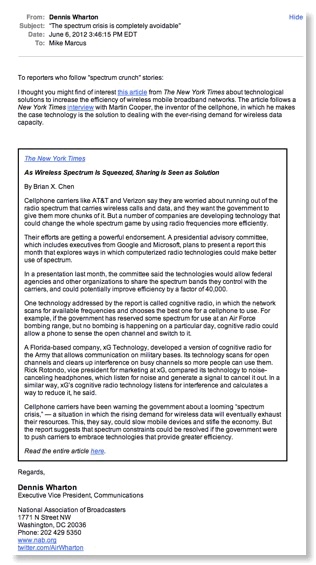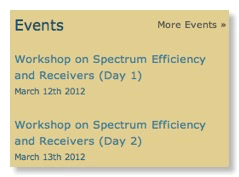NAB: Cognitive Radio is Effective Enough to Allow Sharing of Critical Government Frequencies - But Not Good Enough to Protect Broadcast TV
So you can see how surprised and excited I was to get the e-mail shown at left from Dennis Wharton, Executive Vice President of Communications at NAB, with the subject line “The spectrum crisis is completely avoidable”. We certainly want to avoid this crisis and I was delighted to read what NAB’s new solution was. The message begins with “I thought you might find of interest this article from The New York Times about technological solutions to increase the efficiency of wireless mobile broadband networks.” The Times article was mainly about the PCAST spectrum report that SpectrumTalk readers read about here on May 28th. In the article Mr. Wharton was kind enough to recommend was a discussion of how effective cognitive radio technology now is and the statement “For example, if the government has reserved some spectrum for use at an Air Force bombing range, but no bombing is happening on a particular day, cognitive radio could allow a phone to sense the open channel and switch to it.”
Mr. Wharton, let me explain why it is much easier for a cognitive radio to sense in TV white space whether there are usable TV signals than the case of sensing the presence of military signals:
- TV signals are generally on 24/7, they do not turn on and off at random times as military signals do.
- TV transmitters are firmly bolted to the ground in well defined locations.
- TV signals have a very precisely defined (in a public documentation) 6 MHz wide waveform with very precise frequency stability and timing. It is almost as if they were designed to be detected at much greater sensitivity than a consumer receiver. Indeed, FCC testing showed that they could be detected at a power level 35 dB less than the sensitivity of a TV receiver and better detectors are possible. In general military signals do not have waveforms that are known to the public. Thus the U-NII cognitive radio rules in 47 CFR 15.407(h)(2) require a “Radar Detection Function of Dynamic Frequency Selection” that knows nothing about the radar signal it is trying to detect since the military would no divulge the specific technical details of the radars in the band - a far cry from the well known ATSC signal in the TV band!
- If interference is caused to TV reception, it may be unfortunate but there are no permanent negative consequences - like death or injury. If there is interference to a military system the consequences could me more severe.
Based on the above, cognitive radios in the TV band raise far fewer issues than cognitive radios that try to detect the presence of military signals.
Since Mr. Wharton has concluded that cognitive radio technology has now advanced to the point that it can reliably detect the presence of military signals to allow broadband use of military bands when and where they are not in use, I assume that NAB must now endorse the technically simpler case of using of cognitive radios in the TV bands under similar terms.
I hope Mr. Wharton comes to the DySPAN 2012 Conference in Bellevue WA in October and explains NAB’s new view on cognitive radio. I’m sure he’ll get a standing ovation!
FCC Workshop on Spectrum Efficiency and Receivers
As part of the Commission’s efforts to enhance the use of spectrum for mobile broadband, the FCC Office of Engineering and Technology, in conjunction with the Wireless Telecommunications Bureau and the Office of Strategic Planning will host a workshop on "Spectrum Efficiency and Receiver Performance." The workshop will be held on Monday, March 12, 2012 and Tuesday, March 13, 2012, in the Commission Meeting Room at FCC Headquarters in Washington, DC.
The role of receivers in enabling access to spectrum for new services implicates federal stakeholders, as well as the private sector. Receiver performance issues have often arisen as a conflict between legacy stakeholders and new entrants where deployment of new technologies and services threatens to adversely impact an incumbent or place restrictions on the new entrant. Past examples include interference issues between new cellular radio systems and public safety radio systems, satellite digital radio systems and proposed terrestrial data services, unlicensed WiFi systems and FAA weather radar systems, and ancillary terrestrial service on mobile satellite spectrum and GPS. The resolution of such matters has historically required a public process involving regulators, stakeholders and other parties. Because such discussions sometime begin upon the introduction of a new service or technology, full deployment of such new services could be hindered. New approaches to spectrum management focusing on spectrum efficiency and receiver performance may enable more assured deployment of new services and reduce the necessity for the involvement of regulators.
This two-day workshop will discuss the characteristics of receivers and how their performance can affect the efficient use of spectrum and opportunities for the creation of new services. Key topics will include current practices for receiver design, case studies involving interference due to receiver characteristics, and approaches for promoting interference avoidance and efficient use of spectrum, given the current receiver base and potential future deployments. The workshop will include perspectives from licensees, equipment manufacturers, component providers, and other interested parties.
Apparently there will be panels of speakers, but they have not been announced. Nor has any sort of agenda beyond the above been announced.
(I was surprised by the mention of “unlicensed WiFi systems and FAA weather radar systems” as I have previously written this appears NOT to be a receiver problem, but rather an SDR security issue for the unlicensed cognitive radio systems. Oddly, my September 2011 appeal of an initial redaction of a FOIA request has never been acted on by FCC/OGC. I believe the requested document with fewer redactions would confirm the real nature of the TDWR problem. Motorola is fighting the release of the document with fewer redactions in a “reverse FOIA” action.)
My suspicion is that there is a major coordination problem among the various power that be within FCC on both the agenda and the speakers, probably in their attempt to pacify various industry sectors who have their own view of the issue. Perhaps there is an NTIA problem also.
NTIA has classically been in favor of receiver standards, claiming they have them for federal systems. (Mostly true.) However, NTIA has been unwilling to pressure FAA into adopting 20 year old ICAO Instrument Landing System receiver immunity standards that are used around the world and has been strangely silent on the issue of GPS receiver standards.
In any case, it seems rather strange to have a 2 day workshop with no published agenda 3 working days before it starts.
UPDATE
The afternoon of March 9, the agenda was released.
UPDATE 2
The Powerpoint presentations used are available now on the (ever chaotic) FCC website.
Here are the videos of the 2 days:






![Validate my RSS feed [Valid RSS]](valid-rss-rogers.png)

